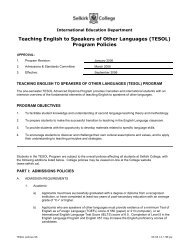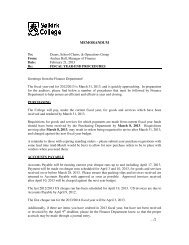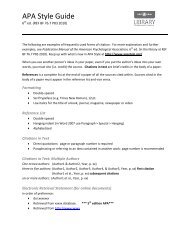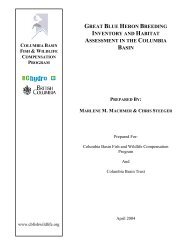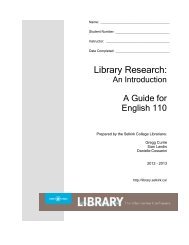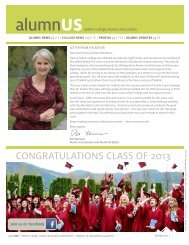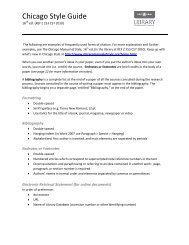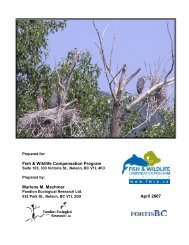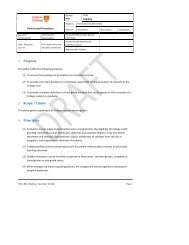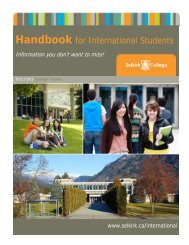selk irk.ca - Selkirk College
selk irk.ca - Selkirk College
selk irk.ca - Selkirk College
Create successful ePaper yourself
Turn your PDF publications into a flip-book with our unique Google optimized e-Paper software.
University Arts and Sciences Course Descriptions<br />
SOC 120 and SOC 121 from Selk<strong>irk</strong> <strong>College</strong><br />
or the equivalent six units of introductory<br />
Sociology from other institutions or written<br />
permission of the Instructor and School<br />
Chair.<br />
Women’s Studies<br />
WS 100 Women’s Studies I<br />
Women’s Studies 100 is an interdisciplinary course<br />
designed to introduce students to the study of<br />
women in global cultures as protrayed through<br />
literature and sociologi<strong>ca</strong>l studies. Topics to be<br />
convered include the women’s movement, sexuality,<br />
“herstory”, gender roles, philosophy and law.<br />
English 12 with a grade of “C” or<br />
better or written permission of the<br />
Instructor and School Chair.<br />
WS 101 Women’s Studies II<br />
A continuation of Women’s Studies 100, WS 101<br />
is an interdisciplinary course designed to expand on<br />
the study of women in global cultures as portrayed<br />
through literature and sociologi<strong>ca</strong>l studies; however,<br />
students do not need WS 100 as a prerequisite.<br />
Topics to be covered include women and religion,<br />
violence, health and reproductive technologies, and<br />
inequality in paid and unpaid labour.<br />
English 12 with a grade of “C” or better or<br />
written permission of the Instructor and<br />
School Chair.<br />
Sciences<br />
Engineering<br />
APSC 100 Engineering Graphic<br />
Communi<strong>ca</strong>tions<br />
This course is an introduction to the principles of<br />
graphic communi<strong>ca</strong>tion used in the engineering<br />
field. In this course the following topics are covered:<br />
orthographic projections; isometric drawings;<br />
section and auxiliary views; dimensioning;<br />
descriptive geometry topics including intersections<br />
and vector analysis; appli<strong>ca</strong>tions vary from geology/<br />
mining to truss analysis. Forms of data presentation<br />
are discussed including Ameri<strong>ca</strong>n and International<br />
standards. AutoCAD is a software tool commonly<br />
used in the presentation of graphi<strong>ca</strong>l information.<br />
Topics covered in the use of AutoCAD include<br />
but are not limited to: template drawings and file<br />
management; setting limits, units, layers and line<br />
types; s<strong>ca</strong>le factors; drawing and editing commands;<br />
creating text and styles; dimensioning and styles;<br />
plotting; solid modeling and design; block creation;<br />
model vs. paper space.<br />
Admission to Engineering.<br />
APSC 120 Introduction<br />
to Engineering<br />
A course designed to introduce students to the<br />
Engineering profession. Information on the<br />
profession, the branches of Engineering, and<br />
the work conducted by practicing Engineers in<br />
the different disciplines is provided. The course<br />
includes field trips to various industries and guest<br />
lectures by practising Engineers.<br />
Admission to Engineering.<br />
Astronomy<br />
ASTR 102 Introduction to Astronomy<br />
Intended for students not majoring in science,<br />
Astronomy 102 is an overview of our present<br />
knowledge of the Universe, including the solar<br />
system, stars, supernovae, black holes, galaxies,<br />
quasars, gamma-ray bursters, dark matter, and<br />
cosmology. Some of the tools of astronomy,<br />
including telescopes and spectroscopes, will also<br />
be studied. Laboratory sessions involving some<br />
indoor experiments and weather-dependent<br />
outdoor observations will be held on alternate<br />
weeks. The laboratory may satisfy the science lab<br />
requirement for Arts programs. This course may<br />
be given elective credit for a degree in Astronomy.<br />
English 12 with a grade of “C” or better.<br />
Biology<br />
BIOL 050 Introduction to Biology I<br />
This course is an appropriate introduction to biology<br />
for students lacking high school prerequisites<br />
who wish to enter a course or program requiring<br />
Grade 11 biology, or who simply want to refresh<br />
their knowledge of the subject. Biology 050<br />
provides a basic introduction to the characteristics<br />
of living things: biologi<strong>ca</strong>lly important principles<br />
of chemistry and physics, cell structure in plants<br />
and animals, bioenergetics, diversity, ecology and<br />
evolution.<br />
ENGL 10<br />
BIOL 051 Introduction to Biology II<br />
This course provides an introduction to human<br />
anatomy and physiology. Topics covered include<br />
mitosis and asexual reproduction, meiosis and sexual<br />
reproduction, genetics, circulation, respiration,<br />
excretion, bones and muscles, nerves, endocrinology<br />
and immunity. A fundamental understanding of<br />
homeostatic mechanisms is stressed. The instructor<br />
may choose to include selected topics on the<br />
structure and function of plants as part of the course.<br />
The course is appropriate for students requiring an<br />
equivalent to Grade 12 biology.<br />
BIOL 050, BIOL 11, or equivalent, or written<br />
permission of the Instructor and School Chair.<br />
BIOL 104 Biology I<br />
A course designed for those students who require<br />
first year biology in their program of study or who<br />
wish to go on to further study in biology. The course<br />
includes cell biology, biochemistry, and an examination<br />
of the processes of life in the plant and animal<br />
body. A strong emphasis is placed on the development<br />
of criti<strong>ca</strong>l thinking skills through problem<br />
solving, research design, and laboratory analyses.<br />
BIOL 12 or equivalent and CHEM 11 or<br />
equivalent. Students lacking the stated<br />
prerequisites may enrol in the course with<br />
written permission of the School Chair;<br />
however, they should be aware that they<br />
will be required to do additional work.<br />
This course is available via Distance Edu<strong>ca</strong>tion,<br />
but requires attendance at weekly<br />
on-site labs.<br />
BIOL 106 Biology II<br />
Along with BIOL 104 (Biology I), this course<br />
provides an overview of the study of living things.<br />
Biology 106 presents topics in population,<br />
community and ecosystem ecology, and classi<strong>ca</strong>l<br />
and molecular genetics. Evolution provides a<br />
unifying theme for the course. A strong emphasis<br />
is placed on the development of criti<strong>ca</strong>l thinking<br />
skills through problem solving, <strong>ca</strong>se studies and<br />
laboratory investigation.<br />
BIOL 104 with a grade of “C” or better or<br />
written permission of the Instructor and<br />
School Chair.<br />
BIOL 164 Human Anatomy<br />
and Physiology I<br />
This course provides an integrative approach to<br />
the normal structure and function of the human<br />
body. Repair and repli<strong>ca</strong>tion, structural support,<br />
nervous integration, movement and metabolism<br />
are examined at the cellular, tissue and system<br />
levels. Recent scientific discoveries are presented as<br />
a means of relating the systems studied to various<br />
applied disciplines including health <strong>ca</strong>re and<br />
Kinesiology.<br />
BIOL 12, CHEM 11, and one of BIOL 11,<br />
CHEM 12, or PHYS 12 (BIOL 11 recommended)<br />
with a grade of “C” or better.<br />
BIOL 165 Human Anatomy<br />
and Physiology II<br />
A continuation of Biology 164, this course covers<br />
the <strong>ca</strong>rdiovascular, respiratory, lymphatic, urinary<br />
and digestive systems. Endocrinology is discussed<br />
throughout as a means of integrating the various<br />
systems to the function of the body as a whole.<br />
The focus remains on appli<strong>ca</strong>tion of knowledge<br />
gained in this course.<br />
BIOL 164 with a “C” or better or written<br />
permission of the Instructor and<br />
School Chair.<br />
204 Selk<strong>irk</strong> <strong>College</strong> 12/13 School of University Arts and Sciences




